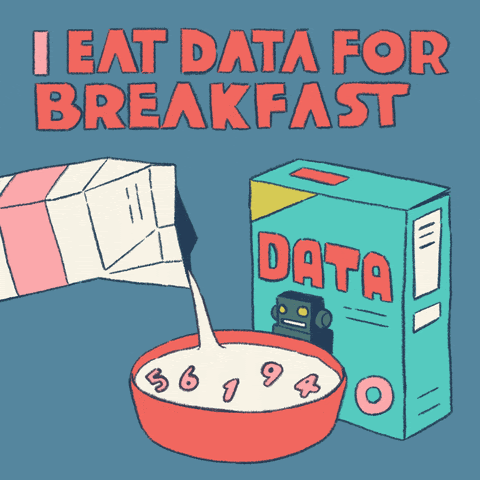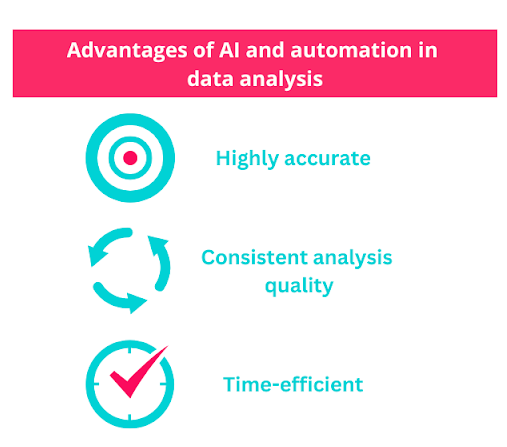October 29, 2025
7 min read
AI vs manual analysis: How AI changes modern data work?
Did you know that only 27% of organizations are able to make full use of their data to generate actionable insights?


AI-powered user behavior analysis automates insight discovery; tools like the user behavior analysis tool CUX leverage AI to accurately pinpoint user frustration and deliver actionable findings faster than manual data sifting.
What is data analysis
First things first, let’s get you settled on the topic by explaining what data analysis exactly is and why it’s so extremely important for modern businesses.
Data analytics is the science of analyzing data sets to find trends and patterns, answer questions and hypotheses, and draw insightful conclusions.
Companies from virtually every industry make use of data analytics (or at least they attempt to) to help them make more informed and data-driven decisions.
What types of data analytics are out there?
Data analytics is a term that encompasses several distinctive categories of data analysis methods, which answer different specific questions:
Descriptive analytics – answers the question: “What happened?”. It’s the process of using current and historical data to identify trends and relationships.
Diagnostic analytics is a form of advanced analytics that examines data or content to answer the question: “Why did it happen?”.
Predictive analytics answers "what will happen?". These tools provide insights about likely future outcomes — forecasts, based on descriptive data but with added predictions using data science and often algorithms that make use of multiple data sets.
Prescriptive analytics answers the question “What should/can be done?” by using machine learning, modeling, simulation, heuristics, and other methods to predict outcomes and provide decision options.
Data science vs data analytics
These two terms sometimes are incorrectly used interchangeably. Data analytics focuses on the examination of data sets to identify and explain trends. Data science looks more at data modeling and production processes, creating algorithms and predictive models.
There is some overlay between the two disciplines, however. The meaning of data science relates to a wider field that focuses on discovering large sets of data. Within that scope there is data analytics, a more focused area that looks at the insights offered by examining existing information.
The challenges & limitations of manual data analysis
Manual data processing had long ago been the go-to method for sorting, interpreting and utilizing data. Some still swear by it, as they put little faith in the wonders of modern AI and machine learning technologies. But are they correct in this?
Some of the tasks that require systematic data analysis, in terms of a digital business, would be:
- Analyzing your customers’ opinions on your brand through gathering data on brand mentions on social media and reviews.
- Dispatching review forms and analyzing customer feedback to evaluate your customers’ User Experience, often trying to gauge customer sentiment
- Interpreting survey results, interviews or reviews to understand customer expectations and preferences
If you are running a relatively small business, you may not have any problems with analyzing these types of data manually. But your business will grow, and whether it happens slowly and over time, or you strike a goldmine with that new campaign you have planned, manual data analysis will simply not be feasible at a certain point.
Relying on traditional techniques and manually analyzing large data sets is incredibly time-consuming, not to mention very easily susceptible to human error, which is not going to help you scale your company. So much as we would love to believe it, human intelligence struggles when faced with overcoming data silos and a constant inflow of information.
Thankfully, we are smart enough to make the impossible actually possible – with the help of Artificial Intelligence and Machine Learning.
What is Artificial Intelligence?
Artificial intelligence (AI), machine learning and big data analytics have become an integral part of gathering and processing business intelligence.
Simply put, artificial intelligence (AI) comprises systems or machines that mimic human intelligence to perform tasks, and can successively improve their performance based on the information they collect.
Natural language processing
An important element of Artificial Intelligence is Natural language processing. NLP is a branch of artificial intelligence within computer science that focuses on helping computers understand the way that humans write and speak, and how to interpret the impact and intention behind different intonations, speaking patterns, or writing styles.
Big data
The term big data refers to massive and complex datasets, and serves as the driving power of the evolution of Artificial Intelligence. Big data analytics goal is to combine and analyze massive datasets to identify patterns and develop valuable insights.
Deep learning
Deep learning is a type of machine learning and artificial intelligence (AI) that imitates the way humans gain certain types of knowledge. Deep learning is an important element of data science, which includes statistics and predictive modeling.
Advantages of AI and automation in data analysis
Why should you use AI tools for Data Analysis? With the rapid advancements in AI, the adoption of AI-powered solutions for Data analysis automation is growing. These solutions are becoming more powerful, efficient, and readily available.
**Practical Example: Analyzing Checkout Drop-off (AI vs. Manual) **
Imagine you want to understand why users abandon your checkout conversion path.
Manual Approach: You might spend days manually watching hundreds of session recordings (user tracking), trying to spot common patterns or points of user frustration. It's slow, tedious, and easy to miss subtle trends or introduce confirmation bias.
AI-Powered Approach: An AI data analytics tool like CUX can analyze thousands of checkout sessions in minutes. It automatically identifies patterns like rage clicks on a specific field, highlights sessions where users got stuck in a confusing user flow, and segments users who dropped off vs. those who converted. The AI surfaces the critical insights related to user behavior analysis (UBA) almost instantly, pointing directly to the problem areas needing optimization.
AI-powered solutions ensure that your data analysis is more accurate and efficient, and the delivered insights are free of bias and common human error.
In contrast to manual data analysis, there is no limit to the amount of data AI for data analysis automation can handle, ensuring efficient processing regardless of data volume. Whether it's 10, 100, or 1000 data sets, an AI data analysis tool will analyze them uniformly each and every time, no need to employ a team of data scientists.
Besides being able to examine vast amounts of data, AI can pinpoint trends and patterns, enabling effective behavioral segmentation needed to improve user experience
Using an AI-powered solution also helps you be better organized – no more endless excel files with hard to grasp information. By leveraging data analysis automation and consolidating data into specialized behavioral analytics tools, you can gain a complete overview

Conclusion: Why AI-powered analysis is the clear winner
Modern AI tools can help you analyze data deeper than ever before.
Thanks to the technological advancements, brought by AI and machine learning, within the data analytics industry, you can rely on these solutions to give you valuable insights, detect trends and patterns that affect your company, and help you make better data-driven decisions.
You don’t need to be a professional data analyst either, when the relevant insights are being presented right in front of your eyes, aving you time compared to processing raw customer journey data manually.
To revolutionize your business analytics, embrace data analysis automation by implementing AI-powered and automated solutions as soon as possible.
